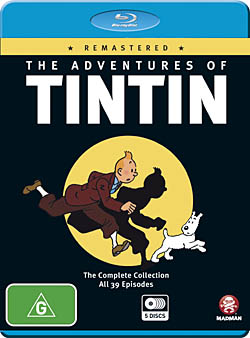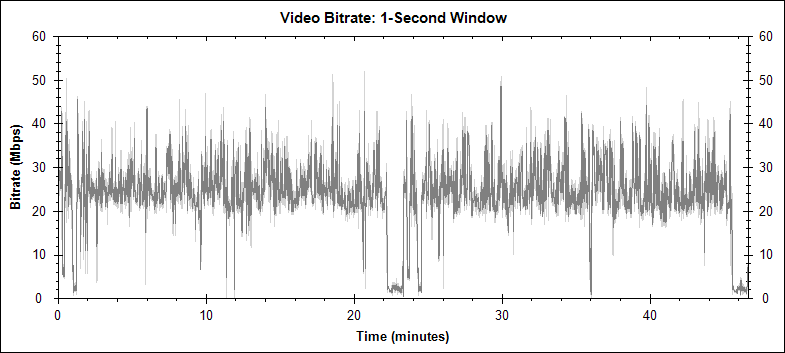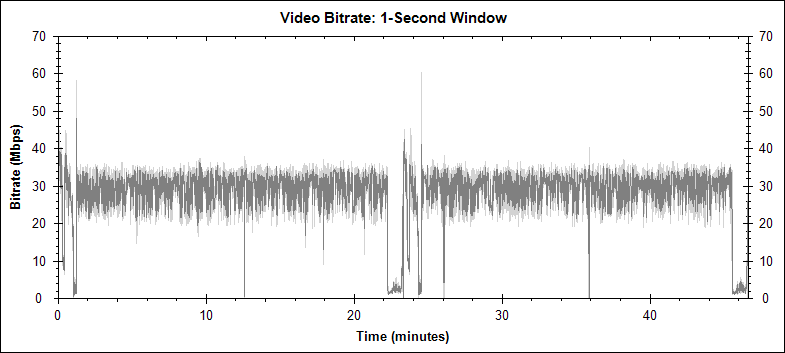 Picture:
Picture:  Sound:
Sound:  Extras: Nil
Extras: Nil

Download scan of review (JPEG, right click, Save As): Page 1, Page 2
Movie:  Picture:
Picture:  Sound:
Sound:  Extras: Nil
Extras: Nil
Between 1929 and 1976 Georges Remi (aka Hergé) created a series of 23 works of the kind which today would be called graphic novels featuring a strangely young-looking reporter, Tintin, and his intrepid dog Snowy.
A very popular series, it turned out, with sales of over 200 million copies.
There have been a number of adaptations, with perhaps the best nearly full one being the French/Canadian production of 1991/1992, 'The Adventures of Tintin'. This has been released here by Madman Entertainment on five Blu-ray discs.
And Tintin has been granted a new lease of life, thanks Steven Spielberg and Peter Jackson in The Adventures of Tintin: The Secret of the Unicorn. I looked at the triple-pack version, which has a 3D only disc, a regular Blu-ray, a DVD, and a code for a digital copy for your portable device.
The TV series has 21 of the stories (Hergé didn't like the first one, and the second is considered racially offensive). Eighteen of them are double episodes of 47 minutes, while three are single 23 minute episodes. Even with this generous treatment, some diversions in the original stories have been omitted. Nonetheless this version is very close to the books, with many of the original book panels being directly copied to the screen.
The picture quality was quite inconsistent. Basically, there were three levels of quality. For the most part there were what were clearly new scans of the film, but a film to which little if any restoration had been applied. The grain was sharp, and the black-outlined characters were perhaps just a touch soft, but more in the sense of HD capturing a slightly older source. There were reasonably constant flecks and motes and small scratches appearing on the screen, but I kind of found them almost charming. This was well worth watching on the full screen. But there were quite a few scenes which were slightly softer, as though in the original filming of the artwork the focus had been a little off.
And then there were bits which had clearly been upconverted from SD video. These were soft, but had obviously been sharpened somewhere along the way at SD resolution, with clear ringing on edges. There were also ghosts of other characters in slightly different positions, suggesting a frame rate conversion. 'The Secret of the Unicorn' was almost completely like this, but with two or three seconds of the higher quality stuff every so often (eg. 12:15 to 12:17 and 15:00 to 15:03) to remind you of what you were missing.
The audio was a serviceable LPCM 2.0, with some data space wasted on this being rendered at 24 bits resolution (c'mon, this is a 1991 TV show!)
At the other end of the picture quality scale is the big budget computer animation, The Adventures of Tintin: The Secret of the Unicorn. I generally like movie adaptations to be as close as possible to the source, but I applaud the writers here in pulling in some elements from other Tintin adventures, and making the language cinematic.
It is a fun ride, this movie, with a great adventure story, and real laughs from Captain Haddock, played by Andy Serkis. The 3D was tasteful rather than flashy, and added a little, perhaps, to the presentation.
But the main reason for adding this movie to your collection is that it is a milestone in animation. The characters were driven from motion capture of real actors, and the 'walking dead' sense that this technique often delivers was completely absent. The eyes were especially well done, the mouths a little less so, but still quite adequately. The only significant weakness was the hands. When picking up things they seemed clumsy.
But even more amazing was the extraordinary richness of the non-character stuff. Entirely created in a computer, it was shockingly beautiful and detailed: the crowds, the scenery, the water, the rooms, the ship. This was largely photo-realistic CGI. Incredible! Jackson's Weta Digital has got to be the best CGI house in the world.
At least, for now.
 (Australian rating); Locked to Region B
(Australian rating); Locked to Region B
The following video bitrate graphs were generated by BDInfo 0.5.7. Here are three episodes picked pretty much at random. First 'The Broken Ear':

Then 'The Crab with the Golden Claws':

Finally 'The Red Sea Sharks':
